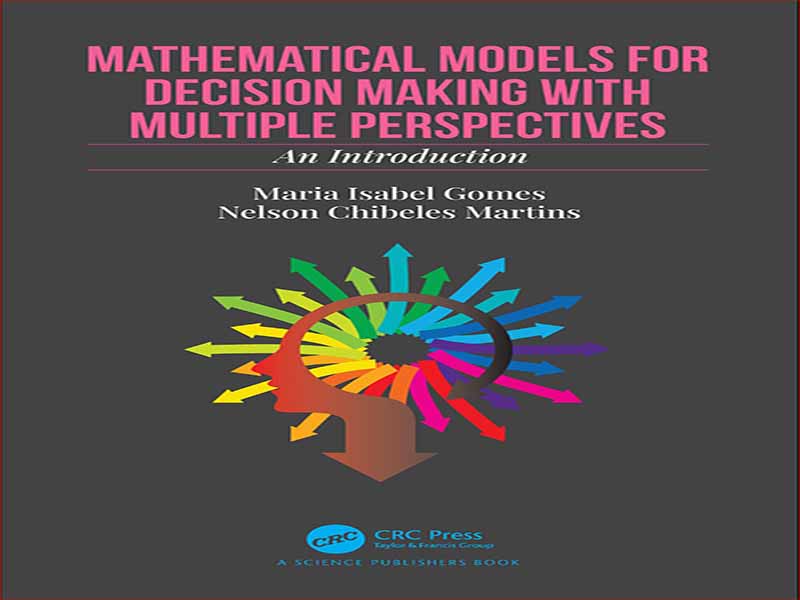- عنوان کتاب: Mathematical Models for Decision Making with Multiple Perspectives
- نویسنده: Maria Isabel Gomes
- حوزه: مدلسازی ریاضی
- سال انتشار: 2022
- تعداد صفحه: 301
- زبان اصلی: انگلیسی
- نوع فایل: pdf
- حجم فایل: 12.4 مگابایت
هدف اصلی ما برای این کتاب درسی این است که در یک جلد، روشهای ریاضی تصمیمگیری داشته باشیم که معمولاً در چندین کتاب پراکنده هستند. ما موضوعاتی را از تصمیم گیری تک تا چند منظر تا ارائه بررسی می کنیم
خواننده (دانشجو) مفاهیم متفاوت اما مرتبط با ساده تر شروع می شود
روش ها و حرکت به سمت روش های پیچیده تر، در نتیجه منحنی یادگیری را هموار می کند.
ما قصد نداریم در هیچ یک از موضوعات پرداخته شده جامع و کامل باشیم. علاوه بر این، ما در مورد جزئیات ریاضی در هر فصل دقت کرده ایم. هدف این کتاب درسی ارائه دوره ای است که اولین رویکرد را در مورد نحوه تصمیم گیری به روش سیستماتیک (ریاضی) به دانش آموزان ارائه می دهد تا آنها را در مورد محدودیت های روش ها و نحوه رسیدگی به آنها آگاه کند. در نهایت، مایلیم راهنمایی هایی ارائه کنیم که خوانندگان می توانند در صورت نیاز به دنبال پیشینه نظری ریاضی بگردند. سوالات مربوط به روانشناسی تصمیم گیری و تاثیر احساسات در تصمیم گیری از موضوع این درس خارج است.
به عنوان یک پیش نیاز، خوانندگان باید از جبر ماتریس اولیه و ساخت مدل در بهینهسازی خطی و رویکرد گرافیکی برای حل مسائل بهینهسازی خطی دو متغیره آگاه باشند. مشکلات با تعداد متغیرهای بیشتر باید با یک نرم افزار بهینه سازی حل شود. ما چند مدل را ارائه می دهیم که به زبان GAMS برنامه ریزی شده اند. با این حال، تمام مشکلات پیشنهادی را می توان به راحتی توسط ابزار حل کننده اکسل حل کرد.
این کتاب در سه بخش تصمیم گیری تک معیاری، تصمیم گیری چند معیاره و بهینه سازی چند هدفه تنظیم شده است.
در بخش اول، فصل 1 بر تصمیم گیری تک معیاری تمرکز دارد. این فصل پایه و اساس دوره باقی مانده را تعیین می کند. این به دانش آموزان اجازه می دهد تا به زبان تصمیم گیری عادت کنند و آنها را با برخی از تکنیک های اساسی و زمینه های مختلف مشکل (عدم اطمینان و ریسک) آشنا می کند. فصل 2 به تصمیم گیری توالی با استفاده از رویکرد درخت تصمیم می پردازد. ما همچنین درباره راههای مدلسازی ذهنیت و نحوه استفاده از آن در هنگام تصمیمگیری بحث میکنیم (مثلاً مفهوم مطلوبیت).
Our primary goal for this textbook is to have, within a single volume, decision-making mathematical methods that are usually scattered over several books. We explore topics from single to multi perspective decision making to present
the reader (the student) different but related concepts starting on simpler
methodologies and moving towards the more complex ones, thereby smoothing the learning curve.
We do not intent to be exhaustive in any of the addressed topics. Moreover, we have been mindful with regards to which mathematical details to include in each chapter. The purpose of this textbook is to present a course providing students with the first approach on how to make decisions in a systematic (mathematical)way, to alert them about the methods limitations and how to handle them. Finally, we wish to provide some guidance on where the readers can look for mathematical theoretical background in case they feel the need to. Questions regarding the psychology of decision making and the influence of emotions when making decisions are out of the scope of this course.
As a pre-requisite, readers must be knowledgeable of basic matrix algebra and model building in linear optimization, and on the graphical approach to solve two-variable linear optimization problems. Problems with a larger number of variables should be solved with an optimization software. We provide a few models programed in GAMS language. However, all the proposed problems can be easily solved by the Excel solver tool.
The book is structured into three parts: single-criterion decision making, multi-criteria decision making and multi-objective optimization.
In the first part, Chapter 1 focus on single-criterion decision making. This chapter sets the basis for the remaining course. It allows students to get used to decision making language and introduces them to some basic techniques and different problem context (uncertainty and risk). Chapter 2 addresses sequence decision making by the means of a decision tree approach. We also discuss ways to model subjectivity and how it can be incorporated when making decisions (e.g. the concept of utility).
این کتاب را میتوانید از لینک زیر بصورت رایگان دانلود کنید:
Download: Mathematical Models for Decision Making with Multiple Perspectives



































نظرات کاربران